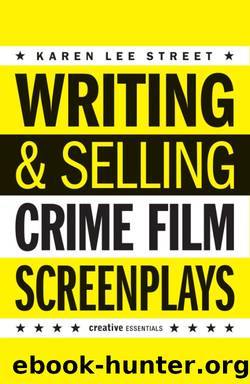Writing & Selling by Karen Lee Street

Author:Karen Lee Street
Language: eng
Format: epub
ISBN: 9781842439753
Publisher: Oldcastle Books
Published: 2013-10-04T00:00:00+00:00
âThey donât advertise for killers in the newspaper. That was my profession. Ex-cop. Ex-blade runner. Ex-killer.â
âThe report read: "Routine retirement of a replicant." That didnât make me feel any better about shooting a woman in the back.â
(Deckardâs narration, Blade Runner)
Blade Runner (1982) is probably the best known film noir set in the future. Based on science fiction writer Philip K Dickâs 1968 novel Do Androids Dream of Electric Sheep?, the story is set in a dystopian, rain and neon saturated Los Angeles circa 2019, a place where animals no longer survive and replicants â utterly life-like robots â live alongside humans. The main character, Deckard, is a jaded, solitary and retired âblade runnerâ whose specialty was terminating replicants when their allotted time was up. He is called back to assist the cops in terminating four escaped replicants. Deckard is on a downward spiral until he meets the beautiful, mysterious, film noir-styled Rachael, who happens to be a replicant. Most of the characters in this world, whether human or replicant, are desperate. Deckard is essentially a hit man who falls in love with a mark. Rachael seems to fall for Deckard, or is she living up to her femme fatale costume and deceiving him to save herself? Despite the sci fi elements of the story world and the vivid neon colours dazzling the midnight blue night sky, the mise-en-scène, atmosphere and tone of Blade Runner are very film noir, as are its characters and the core plot.
Perhaps the big shoulder pads of 1980s fashion inspired something of a revival in erotically charged, fatalistic stories such as Dressed to Kill (1980), Body Heat (1981), Body Double (1984), Sea of Love (1989) and, in 1992, Basic Instinct, followed by Body of Evidence in 1993. These erotic thrillers are sometimes labelled âneo-noirâ, but only Body Heat (loosely based on Double Indemnity) and Sea of Love have the strong dynamic of lust and mistrust between the protagonist and the femme fatale to come across as truly ânoirâ.
A number of historical crime films â films set in a substantially earlier time â utilise classical stage noir tropes, albeit with more graphic violence and sex. Chinatown (1974), Mulholland Falls (1996), LA Confidential (1997) and The Black Dahlia (2006) are examples of this. The Usual Suspects (1995) is a thriller, but has a noir labyrinthine plot, an overall cynical atmosphere, along with plenty of deception and revenge. The resolution is downbeat for most of the ensemble cast. Sin City (2005) is based on Frank Millerâs graphic novels, which are an homage to film noir in terms of characters, story, mood, mise-en-scène and visual style. The film itself is very faithful to the graphic novel and succeeds as neo-noir.
The best neo-noirs utilise film noir conventions in an interesting manner, often driven by a directorâs specific vision. David Lynchâs Blue Velvet (1986) relocates a femme fatale and her abusive partner to small town America where a conservative young man, inadvertently embroiled in the mystery of a severed ear, has his reality unravelled as he tries to save the femme fatale.
Download
This site does not store any files on its server. We only index and link to content provided by other sites. Please contact the content providers to delete copyright contents if any and email us, we'll remove relevant links or contents immediately.
Kathy Andrews Collection by Kathy Andrews(11756)
The remains of the day by Kazuo Ishiguro(8885)
Paper Towns by Green John(5132)
Spare by Prince Harry The Duke of Sussex(5131)
The Body: A Guide for Occupants by Bill Bryson(5022)
Industrial Automation from Scratch: A hands-on guide to using sensors, actuators, PLCs, HMIs, and SCADA to automate industrial processes by Olushola Akande(5021)
Machine Learning at Scale with H2O by Gregory Keys | David Whiting(4256)
Be in a Treehouse by Pete Nelson(3995)
Never by Ken Follett(3873)
Harry Potter and the Goblet Of Fire by J.K. Rowling(3800)
Goodbye Paradise(3758)
Into Thin Air by Jon Krakauer(3341)
The Remains of the Day by Kazuo Ishiguro(3338)
Fairy Tale by Stephen King(3302)
The Cellar by Natasha Preston(3291)
The Genius of Japanese Carpentry by Azby Brown(3249)
120 Days of Sodom by Marquis de Sade(3222)
The Man Who Died Twice by Richard Osman(3035)
Drawing Shortcuts: Developing Quick Drawing Skills Using Today's Technology by Leggitt Jim(3033)
